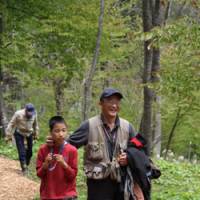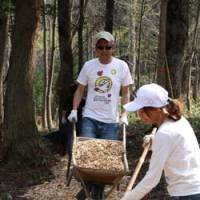I have just returned to my study after two days and a night spent in the woods with a group of young people who are visually disadvantaged. Some of them had no eyesight at all, some could just barely make out shades and vague shapes.
The youngsters, aged from 8 to 15, were visiting us here at our Afan Woodland Trust in Kurohime, Nagano Prefecture, under the auspices of the "One by One" project sponsored by Amway, a global direct- selling company and manufacturer of health, beauty and homecare products.
I made friends with members of Amway many years ago when they were collecting Inuit art for a superb series of exhibitions. They have been sponsoring our woodland programs for children for seven years now — not only with money, but with some of the most enthusiastic and hard-working volunteers we've ever had.
Children with special physical problems need a one-on-one "woodland partner" to accompany them on their sylvan voyages of discovery. Some of these "partners" are such volunteers, who pitch in along with highly competent guides and specialists as we bring the children into woods where bears roam, bees and hornets fly, snakes crawl and midges abound. In other words, Afan is a living woodland, not a tailored park.
We do this because I believe that a living woodland can be a wonderland for all — full of life, sounds, fragrances, textures, adventures and discovery. My heart is full when I see these children full of confidence as they walk, and even run, through the woods, play in the streams and climb trees. They chatter, laugh and sing, and they are invariably full of questions.
We have two programs, both of which we call "Kokoro no Mori" ("Forest Heart"). One is for children who cannot use their eyes as well as most of us, and the other is for children who have been orphaned, abused or neglected. Of all the many projects we have in the woods, including research and education, these programs are closest to my heart. I sincerely believe that a healthy woodland is a place of hope and healing.
At any one time, we can have up to 20 children on one of these programs, along with their group leaders or carers — and often, too, several others who want to observe and learn, or indeed, advise us.
We always split up the groups and spread them through the woods so they can enjoy a variety of experiences. Inevitably, though, everyone sooner or later has to gather in one place, whether for a woodland briefing, for meals, or for talks and exchanges around a campfire.
However, even for just a few days, 30 or more people using a small area of ground will trample it bare, and could cause forest damage. The use of trails can also cause damage such as erosion. These are problems faced by national parks all over the world.
Several years ago, when I turned our woodland into a trust, I was fully aware of this problem and discussed it with my staff. Making hard, unnatural pathways of concrete or tarmac was just out of the question, economically, ecologically and aesthetically. Gravel paths might have been a bit better for the woods, but if the gravel was natural, who knows from which river or shore it had been pillaged, and if it was crushed rock, who knows from which cliff face or hill it had been torn? Besides, the stuff would have to be trucked in, using a lot of energy and road time and costing lots of money. Consequently, I firmly decided that our paths and gathering spaces would be spread in wood chips.
As the forest grows and as we acquire new areas of densely choked and neglected scrub, we have to trim out trees. We use these trees for firewood and charcoal, or for logs to be spored with shiitake and winter mushrooms.
As the overall quality of the remaining trees has improved, we have also been able to harvest hardwood timber to make quality furniture — but please note that we leave the best ones, and only take trees whose removal will enhance the growth of others with more potential close by.
The trees and branches that are not otherwise used are ground into chips in situ, with a machine hired from a friendly construction company nearby.
A big wood-chipper is an expensive machine, subject to hard use, and therefore in need of a lot of maintenance, and it costs quite a chunk of money to hire one. It would be a lot cheaper to buy wood chips from elsewhere, but I absolutely do not want to do that. I insist that we must use our own wood, thus recycling it and returning it back to the forest whence it came.
Here, for any potential woodland-trust founders out there, it may be instructive to digress a tad and explain the bother we are having with a company commissioned by the prefectural government to do some construction work on a waterway that borders our woods and the adjoining national forest.
The only access to that waterway is through our land, and the construction company used a tracked vehicle that tore up our paths and made a muddy mess. They were obliged by law to repair this damage, but when they relaid the path they brought in wood chips made from discarded construction material that was contaminated with paint and preservatives and, to my sensitive nose, smelt like a moldy old building. Consequently, the whole stretch of path has to be cleaned, with the contaminated chips removed, and then relaid with chips from a natural and uncontaminated source.
The construction company had been warned, and knew exactly the quality of the pathway they were destroying with their heavy tractors, but I suppose somebody chose to cut costs. That doesn't work with Old Nic, and the path in question is on the tour route all our Very Important Visitors take. Fortunately, the prefectural officials are on our side and agree with us that the contaminated chips must be replaced.
Now back to nature as it should be.
Our homegrown wood-chip paths smell wonderful when freshly laid, and when they get wet, the sugars in the wood ferment to give a very special aroma. Worms and beetle grubs also make their homes under the chips, which gives us the only problem with the path — wild boar love to grub them up to get at these little delicacies. After a year or so, though, wild mushrooms grow along the edges of the path, and a few years later the chips all turn to compost. Then, if a path is not trodden it returns to vegetated forest floor within months.
We have found that with a soft and pleasant surface to walk on, people tend not to wander off the paths, and even bears like to stroll along them, depositing little Christmas-pudding piles of approval along the way. But perhaps the best thing of all about our wood-chip paths is that they give confidence and pleasure to the children with visual disabilities walking on them. Consequently, we will carry on properly maintaining our paths — and extending their network by around 300 meters a year — for the benefit of one and all, including the bears and wild boar.





















With your current subscription plan you can comment on stories. However, before writing your first comment, please create a display name in the Profile section of your subscriber account page.